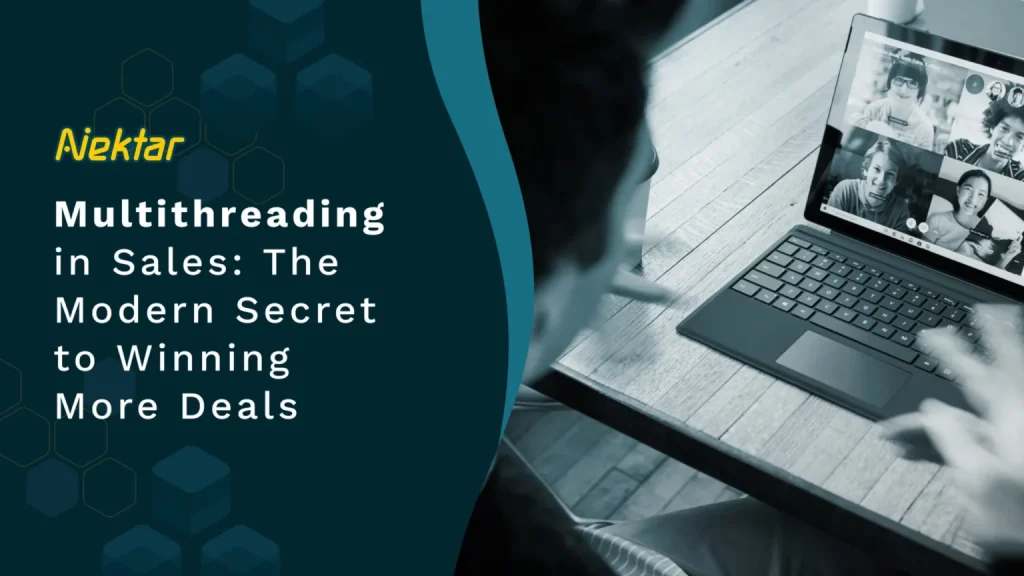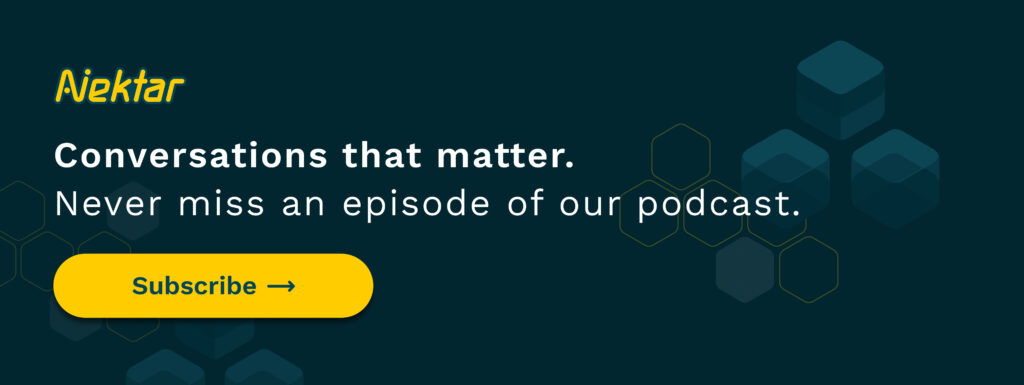
Multithreading in Sales: The Modern Secret to Winning More Deals
- RevOps
- 10 min
B2B buying is no longer a solo act.
Today’s B2B buyer is not an individual but a “buying group.” According to a Forrester survey, 94% of respondents sold to a group of three or more individuals, while 38% sold to groups of 10 or more buyers.
Gartner also found that the number of buyers has increased from 5 to 20 in the last ten years.
This illustrates that the decision to invest in a product or service is not a single person’s job. Instead, it takes multiple rounds of discussions with different stakeholders across departments to make a purchase decision. As high as 82% of decisions are made by a buying group.
Let’s consider technology sellers as an example.
The sales process for technology has moved beyond the IT function. Those outside IT influence 63% of technology purchase decisions. Decision-making now includes other departments such as finance, business development, legal, and compliance.
Digital transformation has put buyers at the center of the process, leading to the buying committee becoming more extensive and diverse. As technology moves beyond functional silos, sellers need to adapt, too.
So, for a successful sale, you’ll need to have the C-suite, marketing, and other stakeholders on board. And remember, all of them value different things.
What does it take to achieve consensus within the buying group? An effective deal closure with “multithreading.”

What is Multithreading in Sales?
Multithreading is when sales reps connect and build relationships with multiple stakeholders in the buying committee of an account. It effectively increases the chances of closing deals even if the champion leaves the buyer organization.
Let’s understand with an example.
Your sales rep has directly connected with the person in charge of implementing your solution (commonly called the “champion”) within their organization. This relationship took several months to nurture and build trust. Suddenly, the champion quits their job for a better opportunity.
What’s your rep’s next point of action?
Your rep may reach out to the new champion. But they have to nurture this relationship for a few more weeks or months to close the deal. There you have it. A lower deal momentum and an increased sales cycle.
In another scenario, there’s no immediate replacement champion identified by your rep yet, and in the meanwhile, the buying committee decides to go ahead with another solution. This turns into a lost deal.
But if your rep multithreads with all the stakeholders of the buying committee, they have a higher chance of closing the deal even when a key stakeholder quits an organization.
Risks of Single Threading
Despite its effectiveness, most sales reps end up choosing single threading.
That is, reps connect and sell to only one person from the buying organization. A LinkedIn study shows that 78% of the sales reps are single-threaded.
The single-threading approach appears less complicated on the surface and may create a stronger relationship with one client. But there are significant downsides to it.
Single threading is the conventional way of one seller interacting with one buyer. It overly relies on one individual from each side (buyer and seller) to see the deal through. But the moment one of them leaves, the sales process is disrupted.
Moreover, a seller loses solid rapport with the buyer when one of them exits the deal. They need to start the process from scratch, leading to longer sales cycles, higher churn rates, and lower win rates.
Take this for numbers. As per LinkedIn, around 25% of buyers change their jobs every year. The result? 80% of sellers admit that at least one deal was lost or delayed due to a prospect or key stakeholder changing jobs. These numbers become significant when considering the loss in revenue.
But you can combat this with a multithreaded approach.
Deploy Multithreading in Sales
Here are six things to check off your list for successful multithreading in sales.
1. Get visibility into your buying committees
Gone are the days when you’d call up Gary from the marketing department, invite him over for lunch and close a deal within the week. Today, it’s the entire buying committee – Gary plus others.
A buying committee comprises of individuals who wield influence in the buying process, spanning multiple departments, roles, and personas. To successfully close deals, understanding the key roles and personas within each buying committee is paramount
So, how do you identify which stakeholders concern you and their priorities? Taking a manual route to getting these contacts into your CRM is a lost cause.
Your sales reps talk to several people on a daily basis. Not all these contacts are fed into the CRM. Worse – only 2-4 contacts make their way into Salesforce. Which means sales managers have no visibility into buying committees.
This gap in contact data, also known as “contact blindness” significantly puts your deals at risk. Not only will reps miss out on building relationships with the right stakeholders, sales managers will be missing crucial insights to coach them on how to move a deal forward.
The first step hence is to make sure you have visibility into the entire buying committee of every deal. You can achieve this with Nektar’s zero adoption contact and activity capture solution. Nektar automatically captures all your hidden contacts from your reps’ sales inboxes and calendars. And feeds it into Salesforce.
Nektar’s AI capability also links contacts to the right accounts and opportunities in Salesforce. It enhances contacts with job titles and buying roles, so that your sales teams have unprecedented visibility into buying committees.
Once you know what your buying committee looks like, you can build an account map and visualize connections between various stakeholder pain points and your solution.
Next, understand their pain points that could drive demand for your solution. If they have an existing solution, what’s their need for a new one, and why they must consider you.
It’s also helpful to understand the influence a given stakeholder has on the overall decision-making process, how long the organization’s buying cycle is, the stages included, and how strong their buying intent is.
2. Multithread early
Now that you have an account map, reach out to the key decision-makers. LinkedIn is your friend here, but you can move one step ahead and use different ways to connect with prospects.
One way is to look at case studies of buyers or their competitors. Case studies generally list challenges the organization faces and how they’re solved. But it’s also where you can find key stakeholders by looking at names, designations, and quotes. Next, look for similar roles in your target account, and boom, you’ve found your decision-makers.
Another way to find decision-makers is to enlist support from your executives. For example, when going over deal reviews, you can tap into their professional network and have them introduce you to relevant stakeholders. Not only will this allow you to make industry connections, but also give you a fresh perspective on your deal.
Alternatively, you can connect with the champion and have them introduce you to those on the buying committee.
Once you’ve connected, set up an initial discussion with a fixed agenda. This meeting will give you firsthand insights into each individual’s roles and responsibilities. You can then introduce your product.
When you’re multithreading in sales, keep in mind that you’re presenting to multiple stakeholders. It’s best to avoid a one-size-fits-all approach and let the committee see customized solutions for various departments. Explain how your solution can impact a marketing priority, save hours of sales time, or otherwise deliver a quantifiable ROI to the C-suite with personalization.
3. Simplify the buying process
In the evolving sales landscape, 77% of buyers state their purchase journey is challenging and complex. There are multiple stakeholders involved, each coming in with their own set of information which may conflict with the group. Moreover, there’s an increasing number of purchase options, leaving buyers confused.
This situation presents an unlikely opportunity for multithreading in sales. Instead of focusing on selling, simplify the process by engaging with buyers.
Here’s how you can follow a buyer-first approach:
a. Learn first, define the problem next
Ask buyers what issues they’re facing and listen more than you speak. Buyers typically share their problems openly to find the best possible solution. Assimilate everything they share and then lay down the problem.
b. Share resources openly
When buyers have high-quality information at their disposal, they’re 26% more likely to purchase. Encourage open communication and share your knowledge as well as relevant resources, giving them the confidence to close the deal.
c. Aim to solve the problem, not sell
Don’t go down the obvious route and push your buyers to make a purchase. Taking from the previous point, you should also avoid an information overload so they don’t get overwhelmed. Act as trusted advisors instead of outright sellers.
d. Deliver value to build trust
Allow buyers to imagine the outcome rather than merely telling them about it. You’ll get their trust and, most likely, their name on the client roster if you articulate the ROI they obtain in real, measurable ways — whether that return is in earnings, time saved, or anything else the customer values.
e. Be open to detractors
Instead of assuming that all members of the buying committee will be impressed, prepare for criticisms. Also, you can welcome questions, suggestions, and concerns right away instead of waiting until you’re deep into the sales process.
4. Drive value
We understand that B2B customers seek it, but what is “value,” and how can multithreading in sales drive it?
Buyers can interpret “value” in multiple ways: optimized prices, compliance with regulations, seriousness about ethical practices, or solving for a unique pain point.
For some, value means meeting varying buying committee needs.
For instance, users have different needs compared to the buyer of the solution. You can align your solution to each business need to drive value. It also helps if you can show prospects how your previous customers benefited from your solution in the form of testimonials, reviews, or case studies.
Gartner’s research found that customers who received information from suppliers that helped advance their buying jobs were 2.8 times more likely to experience better purchase ease and 3 times more likely to go for a bigger deal with less regret.
But don’t just stop at deal closure. Drive value after that, too. Because as much as 57% of customers prefer vendors who also offer post-sales support like integration and enablement, and 47% select vendors based on previous experience.
5. Leverage your relationship with the champion
Even as you begin multithreading in sales with various stakeholders, don’t leave out your champion. Keep communication open. Champions will advocate for you within the buying group when too many decisions are to be made.
Continue nurturing your association with the champion. Go the extra mile and personalize your communication with them every time you connect. Find out how their problems pan out and offer help.
There are a few things you may have to be mindful of. The champion may get offended if you set up a meeting directly with another stakeholder without them introducing you both. In that case, you can invite the champion to sit in on your session. But avoid asking for permission as this opens up the chance for them to say “No.”

Another benefit of nurturing this relationship is that champions will advocate your solutions to other organizations. If they leave the buying organization, they may also approach you for their new company – expanding your prospect list.
In an untoward situation, if you can’t go through your champion, reach out to other possible champions and connect with them on LinkedIn. Alternatively, use your connections to see if you can acquire a warm introduction from anyone else. Emphasize the success you’ve already achieved within their company and how they may join forces.
6. Identify winning patterns to drive rep behavior
With clean and complete contact data about buying committees in Salesforce, reporting will be more impactful. Insights from this data can help sales managers identify patterns in rep behavior that help close more deals. These learnings can be replicated across the sales team. And managers can coach reps better on how to multithread better and push more deals to closed-won.
Sales managers can gain visibility into the depth and breadth of engagement with each member of the buying committee. Such insights enable sales leaders to guide deal owners to execute more effectively.
Managers can get access to leading indicators, which can precisely tell them the activities that their best reps indulge in to close deals. By accessing these business activities being translated into behavior data, your sales managers can figure out the gaps and coach reps on the basis of that data.

These leading indicators give sales managers early insights into opportunities and potential risks that lie ahead, with enough scope to course correct before time runs out.
By depending on leading indicators, managers can know well ahead of time what needs to be done to change behaviors of reps, and turn coaching sessions into proactive discussions rather than reactive meetings.
This way, leading indicators help you see much further down the road for you to predict whether you’ll hit or miss your targets. And if the prediction hints towards an accident ahead, managers can course correct way before the incident takes place.
Hence, using leading indicators as a coaching tool for sales managers allows you to:
1. Have a clear view of what activities lead to success
Your sales reps and managers can know exactly what activities can drive them towards success through real-time data.
2. Review activity data and align behavior to strategy
You can use activity data to measure if your team is making the right behavior switch at the right time to reach goals.
3. Get an early insight into risks
Leading indicators can help view potential risks that may affect future performance. Managers can rectify it in real time much before the damage happens through the right coaching.
Win More Deals With Multithreading in Sales
New problems necessitate innovative solutions, and multithreading in sales is a viable option in the current virtual selling landscape. B2B companies leveraging multithreaded engagements will see revenue growth outperforming their competition by as much as 50% by 2026.
You can close more deals with multithreading by staying connected to key stakeholders of the buying process. It also helps overcome uncertainty when the champion or the sales rep leaves the transaction. An added benefit is it gives you new perspectives and improves your solutions for diverse buyer needs.
Multithread Better With Nektar
Undoubtedly, the main goal of multithreading in sales is to close more deals and drive more revenue. Data-driven insights undoubtedly play a key role in making multithreading a successful practice.
Nektar’s zero adoption contact and activity capture solution automatically creates, updates and maintains your Salesforce contacts, ensuring accuracy and completeness. It’s self healing AI learns from user and tool updates – making sure your CRM data hygiene is always running on auto-pilot.

With Nektar, you can:
1. Automate buying committees
Nektar automates contact capture and links them to the right opportunities and accounts in Salesforce. It enhances contacts with job titles and buying roles, providing insights into buying committees.
2. Track buying committee – seller activity data
Capture the depth and breadth of buyer-seller engagement. Ensure reps are doing enough to win deals with unified activity data across the deal lifecycle within Salesforce.
3. Track buyer job changes
Know when stakeholders from your buying committee in Salesforce move companies. Monitor job changes to multithread effectively for existing deals where champions move. And find net new pipeline opportunities for companies where your champion moves to.
4. Unified CRM data
Trust your CRM with access to clean and complete contact data. Plug all historical and ongoing data gaps in accounts, contacts, opportunities, leads, events and tasks.

Nektar is built for sales. Gain true visibility into buying committee engagement and deal activities.
Have questions? We are here to help.
See how Nektar can help you close more deals by identifying the buying committee and tracking engagement with different stakeholders. We’d love to hear from you and discuss how we can support the unique needs of your business.


Bhaswati
Director of Content Marketing at Nektar.ai, an AI-led contact and activity capture solution for revenue teams. With 11+ years of experience, I specialize in crafting engaging content across blogs, podcasts, social media, and premium resources. I also host The Revenue Lounge podcast, sharing insights from revenue leaders.